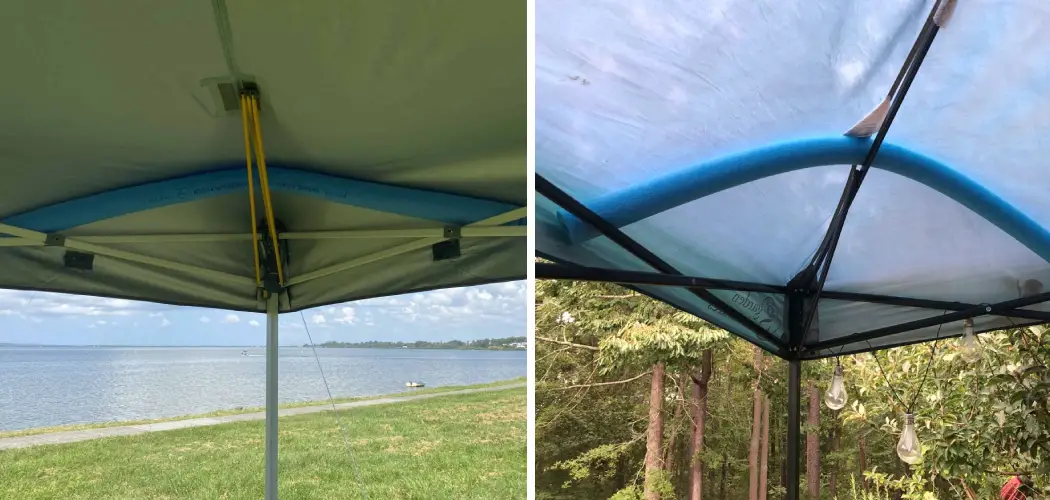If you have a canopy, then you know how frustrating it can be to constantly clean up pooled water during the rainy months. From heavy downpours sending large amounts of water onto your canopy surface to wind-driven rain that pools in those hard-to-reach corners, it’s no wonder many canopy owners find dealing with excess water an uphill battle.
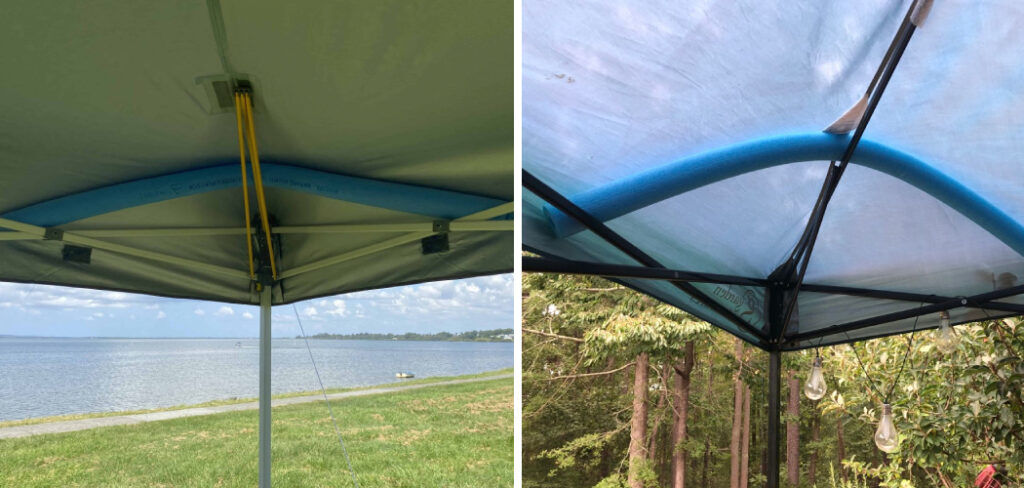
But fear not! There are solutions out there that will help you keep your canvas dry and ready for use – including waterproofing treatments, changing angles of pitch, and using stands designed to direct water away from the area.
In this blog post, we’ll take a look at how to keep water from pooling on canopy, so you can make an informed decision about which one works best for your canvas setup.
What is Pooling?
Pooling is when water accumulates on the top surface of your canopy, creating a shallow pool. This could be due to natural causes such as heavy downpours or wind-driven rain. It can also be caused by improper setup angles that don’t allow for proper drainage.
Why is Pooling Water Important?
Pooling water can cause damage to your canopy over time. The fabric may become stretched or worn out, leading to holes and tears. In addition, the extra weight of pooled water can cause structural damage or even collapse if it is not addressed quickly. That’s why it’s important to take steps to prevent pooling from occurring in the first place.
If you don’t take steps to prevent pooling, then you’ll soon find yourself dealing with a soggy mess on the top of your canopy.
11 Steps on How to Keep Water From Pooling on Canopy
Step 1: Apply a Waterproof Coating
This can be an easy way to protect your canopy from pooling water. There are many different products available that are designed to waterproof and protect your canopy from the elements.
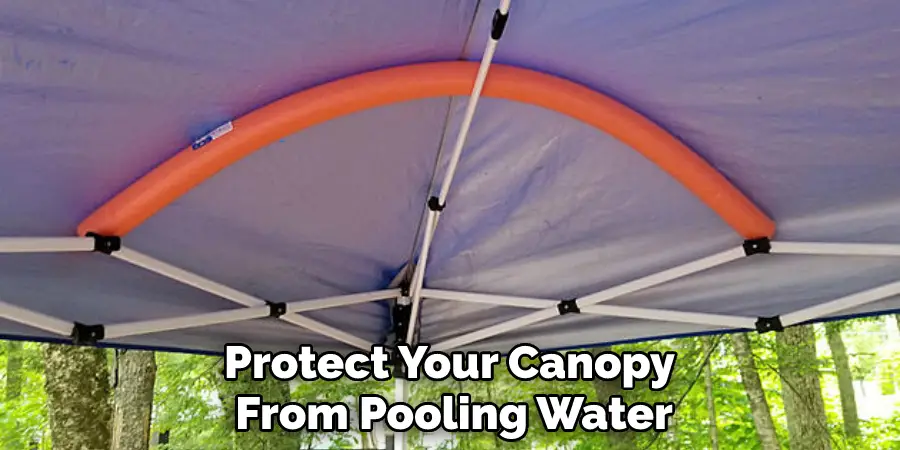
Step 2: Change the Pitch of Your Canopy
If your canopy is pitched too low, it won’t be able to properly drain water away from the surface. Try raising the angle of your pitch slightly so that any pooled water can flow off easily. It will also help if you have a peaked roof-style canopy.
Step 3: Use a Stand
This is especially important for canopies that are pitched too low. A stand can help raise the angle of your canopy slightly, allowing any water to flow off the surface more easily. Using a stand can also help to create a steeper gradient, which can make it easier for water to flow away from the surface.
Step 4: Install Gutter Systems
Gutters are an effective way of directing pooled water away from your canopy. They can be installed along the sides and edges of the canopy, helping to collect any excess water that pools on the surface and direct it away from the area.
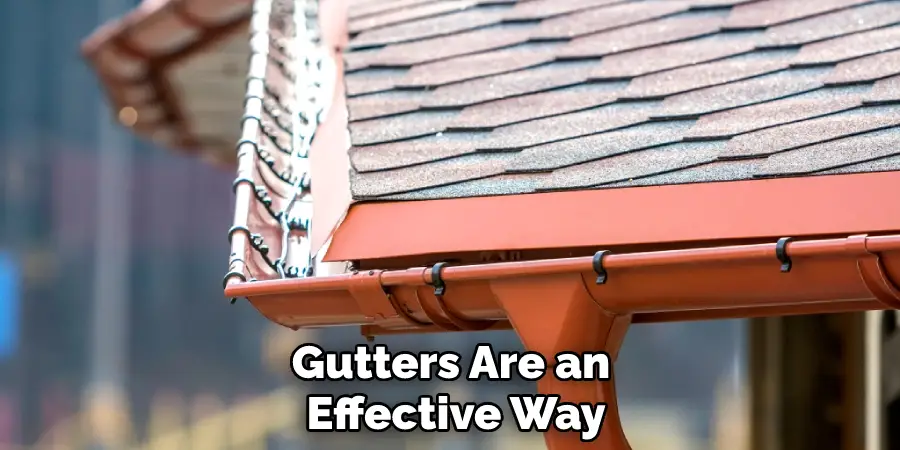
Step 5: Place a Tarp Underneath
If you’re using your canopy outdoors, then consider using a tarp underneath to help collect any pooled water that accumulates on top of the canvas. This will act as an extra barrier between the wet surface and your furniture or other items below.
Step 6: Use a Brush or Squeegee
Regularly brushing or squeegeeing your canopy can help prevent keep water from pooling. This is especially effective when dealing with wind-driven rain, as it can help remove the moisture before it has time to settle and form pools on top of the canvas.
Step 7: Trim Hanging Branches
If your canopy is near trees or other plants, then it’s important to trim any overhanging branches so that they don’t drop water onto the surface. Trimming will help keep the canopy dry and prevent pools of water from forming.
Step 8: Invest in a Roof Drain System
Roof drain systems are ideal for canopies that experience heavy rains. They help to collect and direct pooled water away from the surface of the canopy, preventing it from accumulating and causing damage. This system is especially useful if your canopy is pitched too low.
Step 9: Clean the Canvas Regularly
Regularly cleaning your canopy can help prevent dirt and debris from building up on top of the canvas, which can trap moisture and cause water to pool. Cleaning the canvas regularly will also help to keep it looking its best.

Step 10: Repair Any Tears or Holes
Any damaged areas of your canopy should be repaired immediately, as they can act as entry points for water and cause it to pool on the surface. That’s why it’s important to check your canopy regularly and make any necessary repairs as soon as possible.
Step 11: Keep an Eye on Weather Forecasts
Finally, you should take some time each week to check the local weather forecast. This will help you plan ahead and be prepared in case of bad weather, allowing you to take the necessary steps to prevent pooling from occurring on your canopy.
Following these 11 steps will help ensure that your canopy stays safe and dry and is less likely to suffer from pooling or other water-related damage.
5 Tips on the Maintenance of the Canopy
- Prior to setting up the canopy, it is important to check for any defects or signs of deterioration. Pay special attention to the seams and other points where water can enter.
- Use waterproof tape over any holes or tears in the fabric, as well as around edges and corners. This will provide additional protection against potential leaks.
- When setting up the canopy, make sure that it is taut so that water cannot pool in sags or folds of the fabric.
- Choose a canopy with at least two layers of material to provide better protection against pooling water.
- Always use anchors or weights on your canopy when setting up to ensure that it is secured in place and will not blow away or become unbalanced due to pooling water.
Frequently Asked Questions
How to Stop Canopy From Leaking?
Leaking canopies are a common problem, especially in areas where there is a lot of rain. To stop your canopy from leaking water, you should make sure it’s properly sealed with waterproof sealant and that the seams between each panel are properly caulked.
If necessary, you can also install gutter systems or awnings around the perimeter of the canopy to direct water away from the roof. Additionally, be sure to inspect your canopy regularly and repair any holes or openings as soon as you find them. Proper maintenance and regular inspections can go a long way toward preventing water from pooling on your canopy.
How to Stop Canopy From Sagging?
If your canopy is sagging, it’s likely because of improper installation or a lack of maintenance. To prevent sagging and ensure that the canopy remains level and stable, you should make sure it is securely attached to the frame at all points and reinforced with braces where necessary.
You should also inspect your canopy regularly for signs of damage or weakness and make any necessary repairs. Additionally, you may need to invest in a heavier-duty canopy if your current one is not capable of supporting the weight of rainwater and other elements.
How to Prevent Rain From Pooling on Canopy?
The most effective way of preventing rain from pooling on your canopy is to install gutters or awnings around its perimeter. This will create channels for the water to run off into and away from your canopy, thus preventing it from pooling. Additionally, you can have waterproof sealant applied to your canopy when you first install it and caulk any seams between panels.
It is also important that you inspect your canopy regularly and repair any holes or openings as soon as you find them. With regular maintenance and inspections, you can ensure that your canopy remains water-tight and protected from pooling rainwater.
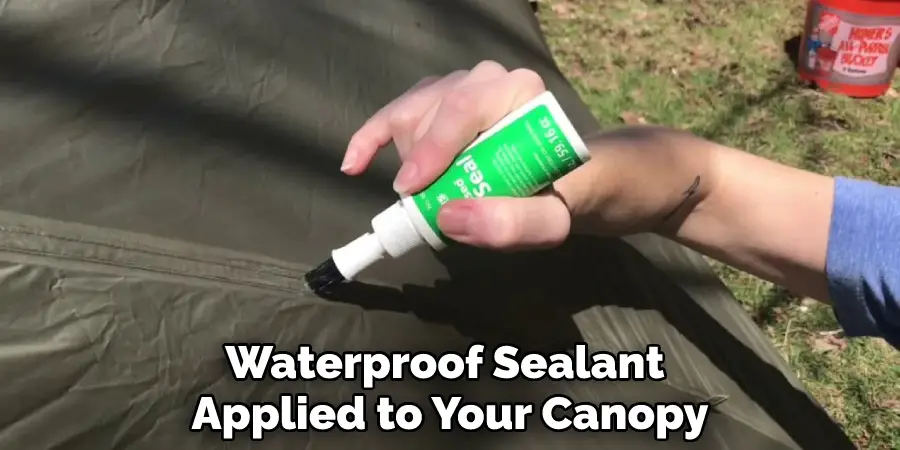
How to Clean Canopy?
Cleaning your canopy is an important part of maintenance and should be done at least twice a year. The best way to clean it is with a mild detergent and warm water, using either a soft brush or cloth to scrub away dirt and grime. It’s also important not to use any harsh soaps or abrasive materials, as these could damage the fabric.
Finally, hang the canopy to dry in a cool, shaded area and inspect it for any signs of wear or tear that need to be repaired. With regular cleanings and maintenance, you can keep your canopy looking new and prevent pooling water from damaging it.
Conclusion
There are a couple of things you can do to make sure the water doesn’t pool on your canopy. You can angle the legs of the canopy so that they slope downward, or you can purchase a weighted foot for each leg of the canopy. Water can also be prevented from pooling on your canopy by using anchors or weights to secure it in place and sealing it with a waterproof sealant.
Additionally, you should inspect your canopy regularly and repair any holes or openings that may lead to water leakage. With regular maintenance and inspections, you can ensure that your canopy remains dry and free from pooling water.
By following these tips on how to keep water from pooling on canopy, you can ensure that your canopy will be able to withstand even the heaviest rains. Do you have any other tips for keeping water from pooling on a canopy? Share them with us in the comments below!
About
Outdoor Fixes is a distinguished figure in the world of Diy design, with a decade of expertise creating innovative and sustainable Diy solutions.
His professional focus lies in merging traditional craftsmanship with modern manufacturing techniques,
fostering designs that are both practical and environmentally conscious. As the author of diy,
outdoorfixes delves into the art and science of outdoorfixes-making, inspiring artisans and industry professionals alike.
Education RMIT University
(Melbourne, Australia) Associate Degree in Design (Outdoor Fixes) Focus on sustainable design, industry-driven projects,
and practical craftsmanship. Gained hands-on experience with traditional and digital manufacturing tools, such as CAD and CNC software.
Nottingham Trent University
(United Kingdom) Bachelor’s in outdoorfixes.com and Product Design (Honors) Specialized in product design with a focus on blending creativity with production
techniques. Participated in industry projects, working with companies like John Lewis and Vitsoe to gain real-world insights.
Publications and Impact
In diy, Outdoor Fixes his insights on indoor design processes, materials, and strategies for efficient production.
His writing bridges the gap between artisan knowledge and modern industry needs, making it a must-read for both budding designers and seasoned professionals.

